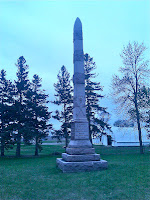 |
| Looking west toward Nicodemus Heights |
 |
| Looking north from Mansfield Ave. |
 |
| Looking north from the North Woods |
 |
| Looking toward the East Woods |
 |
| Looking south toward Cornfield Ave. |
 |
| Looking north across the Cornfield |
WOOLFOLK'S (ASHLAND) Virginia Battery (C.S.) Captain Pichegru Woolfolk, Jr. (Corner Mumma Farm Lane and Smoketown Road)
 |
| Looking southwest on Smoketown Rd |
 |
| Looking east |
 | |||
| Looking north toward the Cornfield |
 |
| Looking southwest at Millers Battery |
 |
| Looking south at the Tower |
 |
| Looking northeast from the Tower |
MILLERS BATTERY, 3rd COMPANY, WASHINGTON ARTILLERY Captain M.B. Miller (South of the Sunken Road in the Piper Orchard)
 |
| Looking south at Cemetery Hill |
 |
| Looking north at Roulette Barn |
 |
| Looking east toward Tower |
 |
| Looking southwest |
 |
| Looking east |
 |
| Looking northwest |
MCINTOSH'S (PEE DEE) SC BATTERY Captain David Gregg McIntosh (Off Harpers Ferry Road near the Zouave Monument)
 |
| Looking northeast |
 |
| Looking southeast |
 |
| Looking east |
New two-gun positions (Photographs shown above:
Captain J. Albert Monroe's Battery D, 1st Rhode Island; Joseph Poffenberger Farm
Captain James Thompson's Independent Battery C, Pennsylvania Light Artillery; Cornfield
Captain Pichegru Woolfolk's Ashland Virginia Battery; Corner Mumma Lane & Smoketown Road
Captain M.B. Miller's 3rd Company, Washington Artillery; Piper Orchard
Captain John C. Tidball's Battery A, 2nd U.S. Artillery; Tidball Trail near Newcomer House
Captain David Gregg McIntosh's Pee Dee South Carolina Battery; South of Hawkins Zouave Monument
Changed
Captain John A. Tompkin's Battery A, 1st Rhode Island; Behind Visitor's Center (2 of 4 guns relocated)
Captain William M. Graham's Battery K, 1st U.S. Artillery; North of Tower; (1 additional gun added)
Captain Charles W. Squires 1st Company, Washington Artillery; National Cemetery (1 gun switched)
Captain Hugh R. Garden's Palmetto South Carolina Battery; South of Cemetery (1 additional gun added)
Captain James S. Brown's Wise Virginia Artillery and Captain James Reilly's Rowan North Carolina Battery; Auto Stop 10 Branch Avenue (2 of 4 guns relocated)
Captain Joseph C. Clark's Battery E, 4th U.S. Artillery; Final Attack Trail; (1 additional gun added)
Captain William J. Pegram's Richmond "Purcell" Virginia Battery; Harpers Ferry Road at Branch Avenue; (2 guns replaced by correct types)
Unchanged:
Captain Joseph B. Campbell's Battery B, 4th U.S. Artillery; West of Hagerstown Pike
Captain Bowyer Brokenbrough's 2nd Baltimore Maryland Battery; West Woods
Colonel Stephen D. Lee's Battalion; Visitor's Center
Removed
Union Sixth Corps gun line; perpendicular to Cornfield Avenue (4 guns relocated)
Boyce's Battery; Piper field (4 guns relocated)
Simmond's Battery; Burnside Bridge (1 gun relocated)
Mumma Farm (1 gun relocated)
The 10-lb Parrot gun at the Visitor's Center was replaced with a 12-lb Napoleon.












